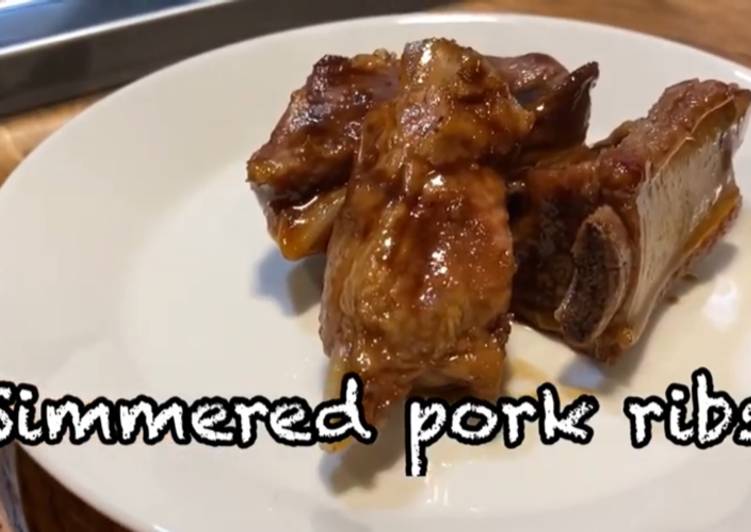Pork Ribs(simmered) Kakuni. Pork belly ribs or spare ribs, or we call it kakuni (without bones) in Japan, cooked until very soft. You can eat with chopsticks no problem. Wait till the pot cools down. Create all people, cooking is indeed something which is quite simple. Besides they are indeed happy cooking and have will cooking that is quite, they are also creative in mixing each dish so that it becomes dish delicious. But there are those who cannot cook, so they must learn and see recipes that are simple to follow.
 At the time, the only port city where foreign ships had access to was Nagasaki and the Chinese dish called Dongpo Pork.
Kakuni (Japanese Braised Pork Belly) - Slow cooked pork belly in soy sauce glaze, serve with shiraga negi and egg on the side.
Kakuni (角煮) is Japanese braised pork belly, and it literary means "square simmered" referring to the shape of this dish.
The end of the day extenuation often promote you over the edge and into a drive-thru window. But truthfully, there are some really quick and easy recipes here to help you get a yummy and ideal meal on the table in no time.
At the time, the only port city where foreign ships had access to was Nagasaki and the Chinese dish called Dongpo Pork.
Kakuni (Japanese Braised Pork Belly) - Slow cooked pork belly in soy sauce glaze, serve with shiraga negi and egg on the side.
Kakuni (角煮) is Japanese braised pork belly, and it literary means "square simmered" referring to the shape of this dish.
The end of the day extenuation often promote you over the edge and into a drive-thru window. But truthfully, there are some really quick and easy recipes here to help you get a yummy and ideal meal on the table in no time.
You can have Pork Ribs(simmered) Kakuni using 4 ingredients or scant. Here is how you cook it.
Materials of Pork Ribs(simmered) Kakuni
- You need 500-700gr of Pork ribs.
- Provide 3 tablespoons of soy sauce.
- Provide 3 tablespoons of Sugar.
- You need 10-20gr of ginger.
I'm not usually into fatty meat but there is. But the extended time that this Japanese-style braised pork belly is simmered with ginger and scallions reduces the fat in the finished dish. Kakuni is a southern Japanese dish that's made by simmering cubes of pork belly in aromatics and seasonings until it's melt-in-your-mouth tender. My version uses a mild braising liquid that makes this Kakuni perfect for using as a topping for ramen, udon, rice, and even sandwiches.
These recipes make in approximately 60 minutes from initiate to finish, and 7 paces. Get ready to screenshot these recipes to get you thru a engaged back-to-school tide!. Here guides how you mix 7 pacesit.
Pork Ribs(simmered) Kakuni guide
- Simmer pork in water for 40 minutes. Very low heat. Half a gallon water. (Approx 2 liters of water).
- Tun off the heat, put lid on top and wait until the pot cools down. 3 hours or so..
- Put ginger and sugar in and simmer in low heat for another 30 mins. Skim the liquid as you cook..
- Add soy sauce and simmer for another 20 mins in low heat. Skim the liquid..
- Turn off the heat, put the lid on and wait until it cools down. 3 hours or so..
- In a different pan, thicken the liquid to make it a sauce..
- Eat. So soft you can tear the meat with chopsticks. It stays soft the next day if you keep it in the liquid. If you do so, reheat it and eat to achieve back the tenderness..
Braised pork ribs and taro stew is one of those lesser known Chinese comfort food dishes that our family used to make during the colder months. It's known as Dwaeji Galbijjim in Korean. Pork ribs are slowly boiled and reduced in a savory blend of Korean spices - until the meat easily pulls off the bones. Baby back pork ribs slowly simmered in gochugaru-based marinade. This Kakuni, or Japanese Pork Belly, is one of the best things ever.
Cooking is activity are normal run by everyone, but not everyone has telenta in making the maximum Pork Ribs(simmered) Kakuni, what are they?
1. Selection the right food ingredients also affect the results of cooking, starting from determination fresh ingredients will be very good because the content of the nutrition is still very good.
2. Furniture The cookware used must also match what is cooked. Also, care must be taken that the cleanliness of the cookware does not affect the taste and nutritional content.
3. How to make Pork Ribs(simmered) Kakuni, which includes which ingredients must be processed first and which ones are processed later and when to add spices. This is done in order to produce cuisine which has nutritional quality and cooked food maturity without reducing the delicacy of the cuisine.
Already know the things you need to consider when cooking Pork Ribs(simmered) Kakuni? Try to use and choose the right food ingredients and follow the steps in cooking properly. good luck...!!!
Braised pork ribs and taro stew is one of those lesser known Chinese comfort food dishes that our family used to make during the colder months. It's known as Dwaeji Galbijjim in Korean. Pork ribs are slowly boiled and reduced in a savory blend of Korean spices - until the meat easily pulls off the bones. Baby back pork ribs slowly simmered in gochugaru-based marinade. This Kakuni, or Japanese Pork Belly, is one of the best things ever.